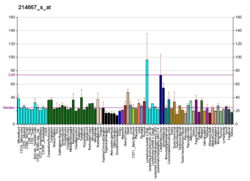Tumor protein p53-inducible protein 11 is a protein that in humans is encoded by the TP53I11 gene.[5][6]
Further reading
- Andersson B, Wentland MA, Ricafrente JY, et al. (1996). "A "double adaptor" method for improved shotgun library construction". Anal. Biochem. 236 (1): 107–13. doi:10.1006/abio.1996.0138. PMID 8619474.
- Yu W, Andersson B, Worley KC, et al. (1997). "Large-Scale Concatenation cDNA Sequencing". Genome Res. 7 (4): 353–8. doi:10.1101/gr.7.4.353. PMC 139146. PMID 9110174.
- Strausberg RL, Feingold EA, Grouse LH, et al. (2003). "Generation and initial analysis of more than 15,000 full-length human and mouse cDNA sequences". Proc. Natl. Acad. Sci. U.S.A. 99 (26): 16899–903. doi:10.1073/pnas.242603899. PMC 139241. PMID 12477932.
- Liang XQ, Cao EH, Zhang Y, Qin JF (2004). "P53-induced gene 11 (PIG11) involved in arsenic trioxide-induced apoptosis in human gastric cancer MGC-803 cells". Oncol. Rep. 10 (5): 1265–9. doi:10.3892/or.10.5.1265. PMID 12883691.
- Ota T, Suzuki Y, Nishikawa T, et al. (2004). "Complete sequencing and characterization of 21,243 full-length human cDNAs". Nat. Genet. 36 (1): 40–5. doi:10.1038/ng1285. PMID 14702039.
- Liang XQ, Cao EH, Zhang Y, Qin JF (2004). "A P53 target gene, PIG11, contributes to chemosensitivity of cells to arsenic trioxide". FEBS Lett. 569 (1–3): 94–8. doi:10.1016/j.febslet.2004.05.057. PMID 15225615.
- Fingrut O, Reischer D, Rotem R, et al. (2006). "Jasmonates induce nonapoptotic death in high-resistance mutant p53-expressing B-lymphoma cells". Br. J. Pharmacol. 146 (6): 800–8. doi:10.1038/sj.bjp.0706394. PMC 1751213. PMID 16170329.
- Kimura K, Wakamatsu A, Suzuki Y, et al. (2006). "Diversification of transcriptional modulation: Large-scale identification and characterization of putative alternative promoters of human genes". Genome Res. 16 (1): 55–65. doi:10.1101/gr.4039406. PMC 1356129. PMID 16344560.
- Xiong XF, Li H, Cao EH (2007). "PIG11 protein binds to DNA in sequence-independent manner in vitro". Biochem. Biophys. Res. Commun. 358 (1): 29–34. doi:10.1016/j.bbrc.2007.04.048. PMID 17482569.




